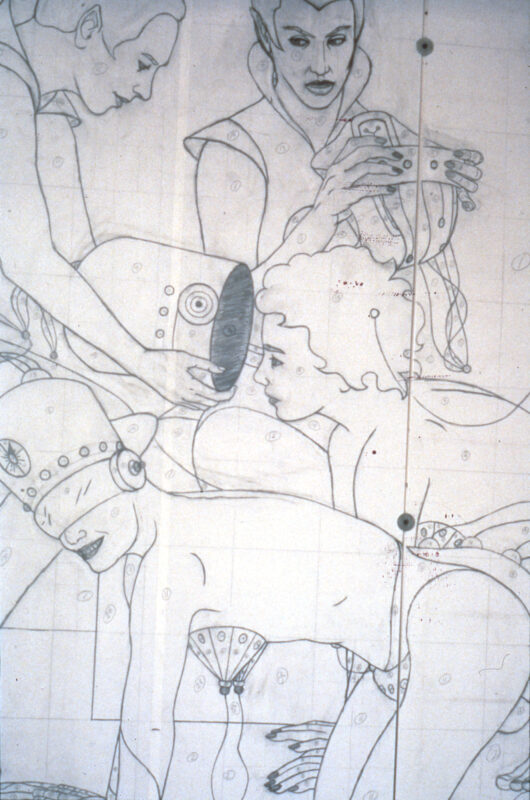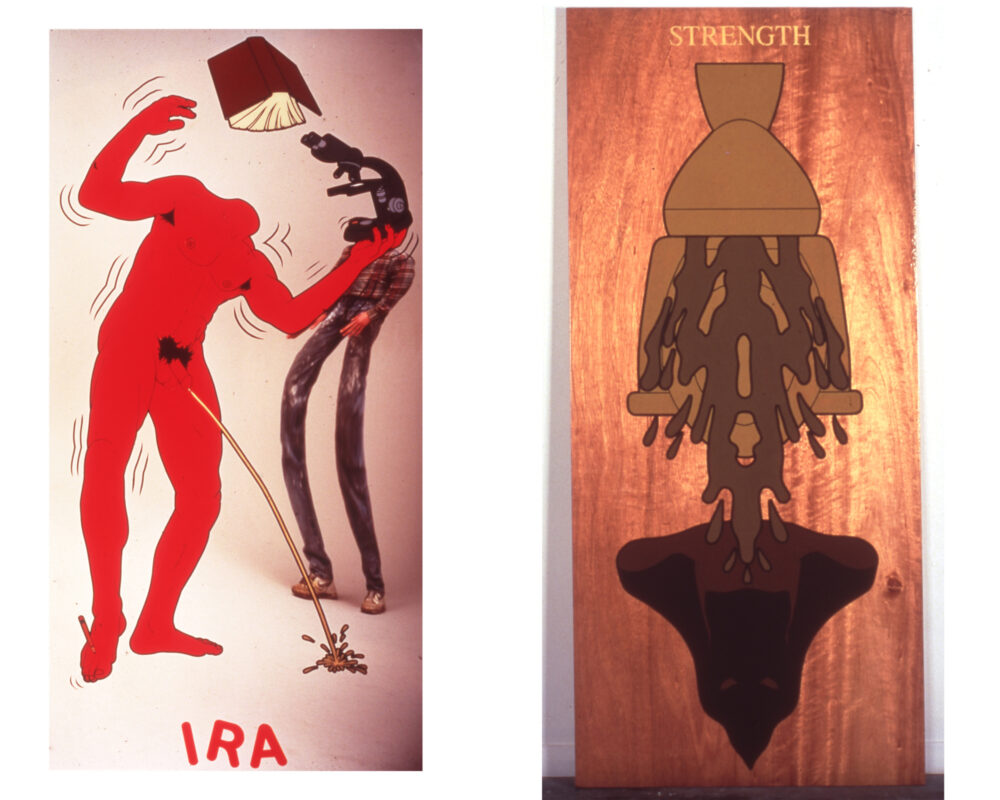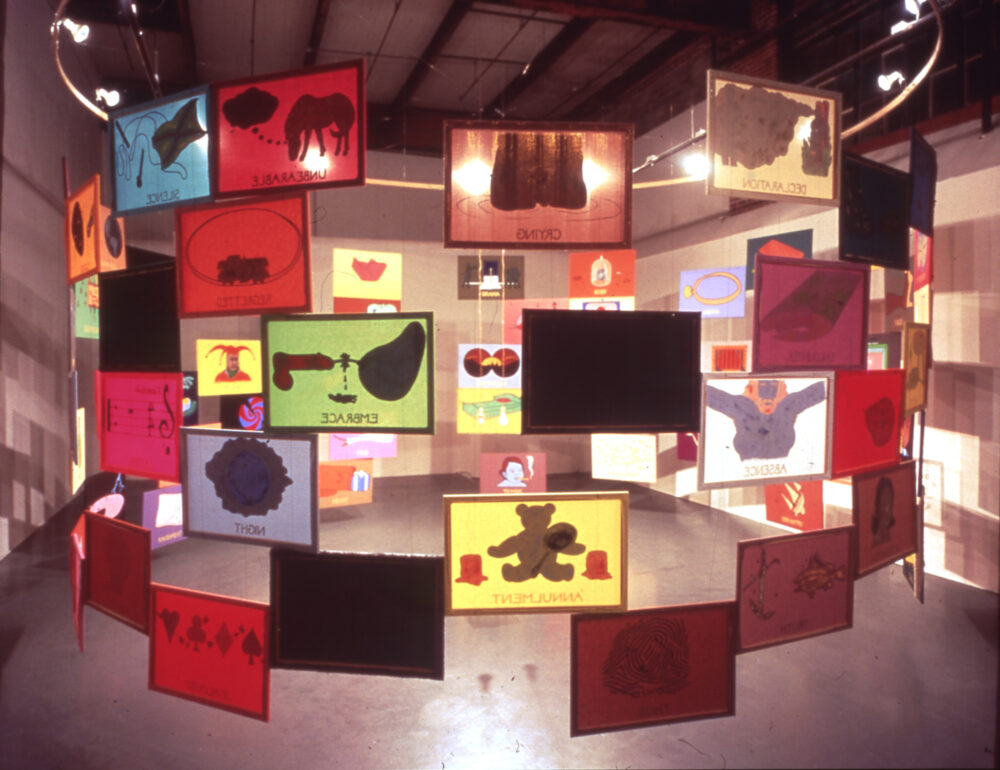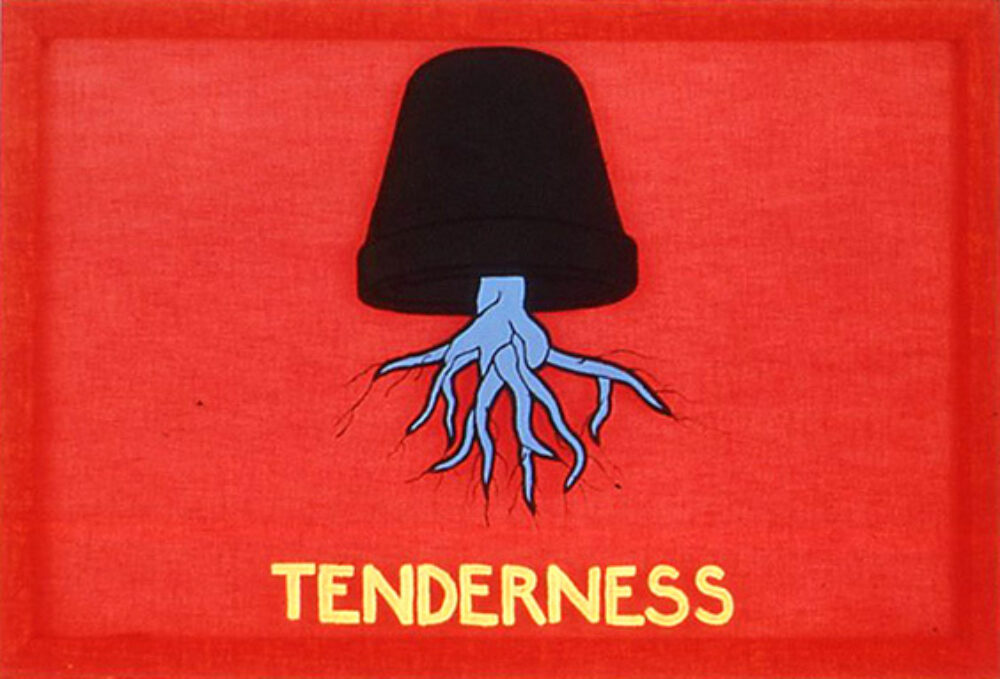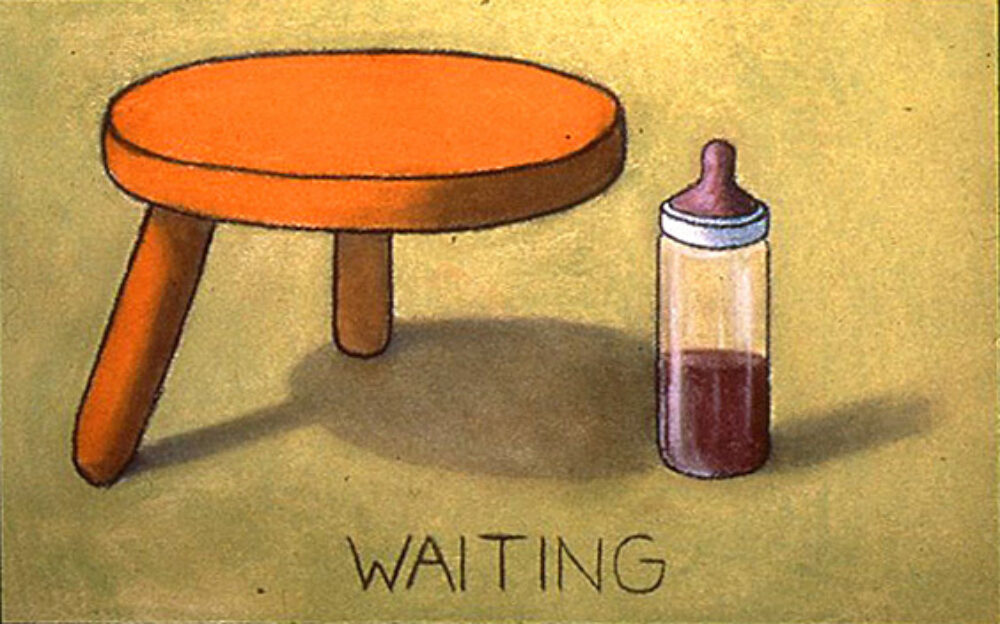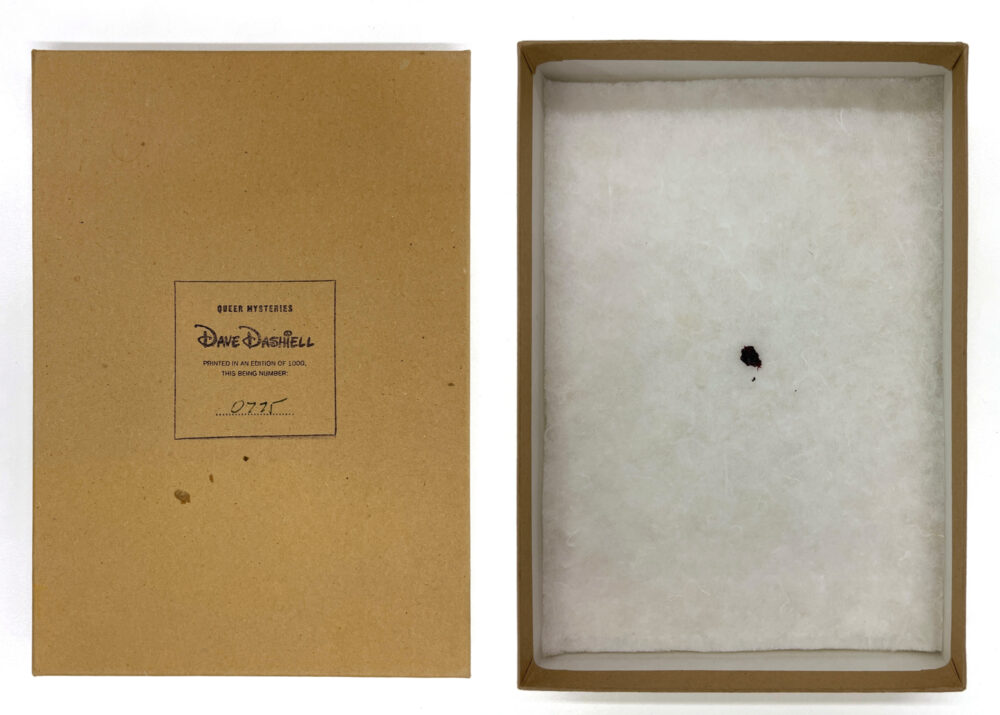Dashiell was convinced of art’s potential to pack an analytical punch. This ideas-based approach to art-making was not coincidental. California boasted an ebullient conceptual alternative art scene, propelled by non-profit, artist-led galleries and the funding of a state with progressive politics.3 Dashiell had studied at CalArts, Valencia, where he received his BFA in 1974 and his MFA in 1976. At the time, CalArts was somewhere between famous and notorious for being particularly theory driven. Students would have been exposed to the publisher Semiotext(e)’s pivotal translations of French postmodern heavyweights. From Jaques Derrida to Michel Foucault to Jean Baudrillard to Julia Kristeva to Roland Barthes – these were all writers whose challenges to authority, culture, language, sexuality, and gender were fertile ground for fresh, queer, artistic minds. At CalArts, Dashiell was mentored by John Baldessari, the conceptual artist known for exploring the associative slippages between image and language. Dashiell too, then, was sure of art’s power to say something, to have a conceptual backbone. Yet, crucially, he was also sure of the need for the representational practices of an artwork to be keenly self-aware, and never didactic or moralising.
Dashiell’s interest in representational practices surfaced through an interest in semiotics. Semiotics is the study of communication. As such, it is no stranger to queer life, theory, or art. For example, Hal Fischer’s photographic book Gay Semiotics (1984), recorded the non-verbal language of queer male life in the Castro: bondage gear, the ‘hanky code’ and jock drag archetypes – they speak for themselves.4 Not only do these visual codes communicate a reality, such as gender identity or sexual preference, but they are also tirelessly implicated in the creation of that reality.5 What is gender but a performance, a series of communicative acts that make up that gender?6 What is a leatherman without his leather gag, paddles and mask?
For the postmodern theorist Roland Barthes, the problem occurs when seemingly innocent signs come to stand for meanings they have accrued by mere proximity, metaphor, or stereotype. These meanings can be made to appear natural, absolute or frozen, rather than created or constructed – they become myths. A poignant example of this, and its dangerous consequences, is the discourse of right-wing populism and the tabloid press during the HIV/AIDS epidemic. Under this rubric, HIV/AIDS became “the gay disease,” a purposeful conflation of cause, consequence, and contiguity that naturalised the myth that sexual activity and homosexuality lead to disease and death, in turn providing an ideological basis for the US government’s desertion of PWAs.7 Given the role of semiotics in both celebrating and oppressing queer life, Dashiell’s interest in the mysterious interstices of making meaning is apt. But how does this theoretical underpinning come into play?
Queer Mysteries (1993) is an ambitious, floor-to-ceiling project of hyperbolic verbal and visual punning. It draws its visual identity from the frescoes of the Villa of the Mysteries in Pompeii (1 BCE), appropriating its unruly bodies and cultic scenes of sexual initiation and dragging them into the late 20th century.8 Clusters of bodies intermingle orgiastically against a beefsteak-red backdrop, contorting their way through a series of imagined sexual rites until, at its climax, two initiates are persuaded into their new, queer identities. The installation fucks with "stereotypes of gays as out-of-control, sexually insane, Jeffrey Dahmer types” – and herein lies its brilliance – painting a semiotic subversion of homophobes’ worst nightmares.9 Or are they fantasies? Let me briefly bring to mind queer theorist Gayle Rubin’s canonical indictment of society’s dividing line between “good sex” and “bad sex.” What society considers to be “bad sex”, says Rubin, is all sex that is “homosexual, unmarried, promiscuous, non-procreative, commercial, alone or in groups, casual, cross-generational, in public, pornography, with manufactured objects, sadomasochistic.” Rubin’s analysis identifies society’s domino theory of sexual peril, in which it is feared that permitting one “bad” sexual act to cross the line will lead to every “bad” sexual act being permitted.10 With Queer Mysteries Dashiell nudges that first domino with glee.
This turn towards a source of Classical mythological stature speaks to a recurring mode in Dashiell’s work: the appropriation and queering of an established system. Myth, in the Ancient Greek sense, refers to the explanation of phenomena through a story or narrative typically involving supernatural beings.12 A myth is a means to explain. It is a system of knowledge. Queer Mysteries looks to the past for a means to, if not understand, then at least to grapple with a present hit by a devastation of supernatural proportions, “an attempt to get to very, very difficult content.”13 Born in 1952, Dashiell had grown up in a born-again Christian household and, as a result, his internalised homophobia had a strong grip. As a child, his father (a CIA operative) had sent him to Christian deprogramming centres. “To this day, I have a rabid reaction when I hear about religious cults,” Dashiell confessed in an interview.14 And contracting HIV in the mid-1980s didn’t make life any easier. “Just about the time I got used to being who I was, AIDS came along, and… the notion of divine retribution went through my head. I felt guilty, a victim, dirty, you name it.”15 But making art helped. It provided a means to work through his own complicated relationship to sexuality and AIDS. The overarching mythological structures of religion, such as ritual, iconography, sacred story-telling, afforded a “compelling, overall system” to work with.16
Dashiell’s earlier work The Pantocrator’s Circus (1989–90) took from such Christian mythology.17 Referencing Hieronymous Bosch’s The Seven Deadly Sins and the Four Last Things (circa 1500), this installation plays again with “the popular misconception of disease as holy retribution,” resituating medieval sins in contemporary culture.18 Seven life-sized bodies are painted onto funhouse mirrors. Each pairs a sin with a disease, its signifiers overloaded with a plethora of carefully planned elements. Lust is AIDS, of course. Pride is bulimia, a woman with the emaciated, heroin-chic body of the 90s, who steps in her own vomit and holds a camera to her ass. On another panel, a prepubescent boy kneels on a Catholic prayer stool, holding an American flag to his heart. Between his legs is a pile of shit – he seems to have had an accident, punning the Latin term for laziness: accidie. This figure signifies religious worship and unthinking patriotism. Dashiell diagnoses the negative moralizing towards PWAs as only one among many instances of physical discrimination in an America that is, at its core, founded upon the oppression of othered bodies: bodies who struggle with substance abuse, bodies with eating disorders, bodies with HIV/AIDS. Perhaps America’s most pervasive illness and ultimate sin, then, is its treatment of these bodies. When myth presents to us history as though it were nature, says Barthes, the best tool for dismantling it is to mythologise it and, in turn, produce an artificial myth.19 And so, as the cartoonish figures parade their gaudy colours around the carnivalesque mirrors, each “diseased” body is revealed as artificial, or to some degree fabricated. With this Dashiell articulates one of the central points of disability and sick studies: that language and reality are engaged in a process of co-creation, and that perhaps bodies are not always inherently disabled – that they are disabled, at least in part, by a state that leaves them without care or provision.20
For all the bodily functions and somatic indexes of Dashiell’s work – the welts caused by Kaposi’s sarcoma and the bodily excretions of The Pantocrator’s Circus; a vomiting toilet in the autobiographical project Invert/Oracle – his work is not the fleshy voracious work of Jerome Caja.21 Neither does it partake in the abjection of David Wojnarowicz or Diamanda Galás.22 No, the tone of Dashiell’s transgression is slant and sly. Images of orgiastic sadomasochistic glut; of rabid man-chomping; of bodies severed, reassembled and sutured at the joints; of lubrication and ejaculation – all these bodily excesses are contained by slick contours enclosing solid blocks of unshaded colour with little visual depth.23 Dashiell’s style eschews affect, instead carrying with it the wit of the comic-book strip and its facility for double (or triple, or quadruple) entendre. Facial expressions are cool and collected, holding the viewer at arm’s length.
We might call this length, this arm’s length, critical distance. The ambivalent countenances, the sardonic tone of the installations – Dashiell’s work is anything but straightforward, and it seems reductive to describe it merely in terms of queer activism or social commentary. Dashiell’s art is gay, sure, and imbricated in queer issues. As early as 1986, he participated in SPARC Gallery’s Artists Against AIDS.24 But Dashiell’s art is also G.A.Y. It’s Great Art, Yeah? In conversation with Nayland Blake in 1990, Dashiell said, “I’ve always had trouble with the idea of a gay sensibility. There are as many gay sensibilities as there are any other kind. [...] So thinking in terms of a sensibility where we are critical of the world and ourselves, then yes, [my work] has a gay sensibility.”25 Perhaps it is this critical outlook, paired with the high level of intertextual erudition in his work, that prompted the description of Dashiell and his San Francisco contemporaries as the “gay intelligentsia.”26 This group of clever queers included curators, artists and writers such as Nayland Blake, D-L Alvarez, Glen Helfand, Scott Hewicker and Cliff Hengst. They were the driving force behind an independent art scene (nestled in and around The Mission District, a stone’s throw from The Castro, San Francisco’s famous gay district)27 which had developed due to the mainstream art scene turning their backs on queer and PWA artists during a time of moral panic.28 Smart, subversive, and often sexy, this was the art scene that would allow Dashiell to exhibit pieces such as Queer Mysteries, deemed by an Art Week reviewer to be better suited to a “covert rave” or "sex club” – not an art gallery.29
Dashiell’s critical eye takes a wider glance in the installation A Lover’s Discourse (1987), in which a copy of the eponymous book by Roland Barthes is bolted to the top of a small table.30 Eighty canvases are placed like a panopticon around the table, each one pairing a painted image with a word in the realm of sexual obsession. The pairings are pointedly obscure, necessitating the viewer to make their own connections between them. This surfaces as the running thread of Dashiell’s oeuvre (so much so that the entirety of this writing could easily be blown out of the water by another’s interpretation). The saturation of meaning, or the multiplicity of its interpretation, implicate the viewer. Of course, a piece like Queer Mysteries is immediately appellative – in its bright, flat colours; its sheer magnitude, both physically (life-sized and submersive in its arrangement around the room) and cosmically (wordly themes of identity and of sex, of life and of death); the provocation of its sexual content and strange characters – yet what sustains the viewer’s attention is its utter constructedness. The anachronistic juxtapositions of discursive and visual elements – Roman frescoes, with B-movie sci-fi, with 19th CE pith helmets – forces their collision and collapse. The viewer is called upon to pull apart these elements, to discern their potential meanings. In doing so, every viewer must confront their own introjected mythologies, and reveal their participation in ossifying societal and cultural mythologies.
I return again to the anecdote of the boa. Snaking its way through Dashiell’s web of references and intellectual allusions is the ultimate brilliance of his work: his “mordant wit,” as friend Rebecca Solnit recalls.31 Dashiell signs catalogues by stamping his name in the Walt Disney font saying, deadpan, “You think I'm gonna be here for a lawsuit?”.32 He sneaks tissues stained with fake blood into the pages of his catalogues, a stark provocation on the white. In 1991, Solnit and Dashiell spray-paint a plastic turd gold, call it The Philosopher’s Stone and install it at the door of an art gallery.33 He had an uncompromising irreverence, even (or perhaps especially) towards the illness that would kill him and many others. In 1992, he and his partner Louis De Vries bought a table for their dining room, a restaurant service one made from stainless steel. “He wanted the dining room table to look like a morgue table,” says Tim O’Toole, friend and studio assistant.34 All around the table were arranged six wheelchairs, upholstered in “dark watered satin with fringe dripping from the arms,” a wink at how the disease would disable him.35 From Dashiell, I learn that irreverence and ingenuity are the best tools for resistance. And that confronting your enemies with their own terms may be the most effective kick against them.
Works Cited
1. As recounted by Tim O’Toole, Dashiell’s former studio assistant. After receiving the Adaline Kent Award, a retrospective of Dashiell’s work was exhibited at the Walter/MacBean Gallery at the San Francisco Art Institute (SFAI). Tim O’Toole, Zoom interview with the author, March 16, 2022.
2. Sono Osato, Zoom interview with the author, March 16, 2022.
3. Jean-Edith Weiffenbach, “What Bay Area?,” Art Journal, Vol. 53, No. 3, Autumn 1994.
4. Hal Fischer, Gay Semiotics: A Photographic Study of Visual Coding Among Homosexual Men (NFS Press, 1977)
5. Roland Barthes, Mythologies, trans. Annette Lavers (Jonathan Cape, 1972), 108.
6. Judith Butler, Gender Trouble (Routledge, 2002), 33.
7. Gayle S. Rubin, “Thinking Sex: Notes for a Radical Theory of the Politics of Sexuality” in Pleasure and Danger: Exploring Female Sexuality, ed. Carole S. Vance (Routledge and Kegan Paul, 1984), 164.
8. Karen Bradway, Villa of Mysteries: Pompeii Initiation Rites of Women (C.G. Jung Institute, 1982).
9. Robert Friedman, “A Conversation with David Cannon Dashiell”, ARTWEEK (July 8, 1993), 8.
10. Rubin, “Thinking Sex”, 153.
11. Though Dashiell features increasingly prominently in several local and national arts magazines from 1985–1993, contemporary research on his work is scant. There exists only one longform analysis of Dashiell’s work, a brilliant piece by Alison Marie Syme which fleshes out all the psychosexual interpretations of Queer Mysteries. Alison Mairie Syme, “Love among the Ruins,” Art Journal 63, no. 4 (2004): 80–95.
12. Oxford Reference, “Myth,” accessed August 29, 2022, https://www.oxfordreference.co...
13. Nayland Blake, “Interview: David Cannon Dashiell,” SHIFT 4, no. 2. (1990).
14. Blake, “Interview: David Cannon Dashiell.”
15. Torri Minton, “Artist’s Story of AIDS,” San Francisco Chronicle (February 9, 1993), 14.
16. Blake, “Interview: David Cannon Dashiell.”
17. In 1990 Dashiell won the Art Space Award, along with Deborah Oropallo, and Rick Arnitz. For the 1990 Art Space exhibition, David presented The Pantocrator’s Circus, developed during a residency at the Headlands Center for the Arts, an abandoned military base reclaimed as artists’ studios.
18. Minton, “Artist’s Story of AIDS.”
19. Barthes, Mythologies, 134.
20. Alison Kafer, Feminist, Queer, Crip (Indiana University Press, 2013), 7.
21. Jerome Caja’s pieces have a more immediate and materially voracious relationship with the body, extending even to the substance of the artworks, in making art out of materials like nail polish and human ashes.
22. Both artists deploy a sense of bodily horror to speak to AIDS in their artworks.
23. Dashiell’s sartorial approach to the queer body, with its seams and stitches, brings to mind Susan Stryker’s theory of the trans body as a monstrous body: “I find a deep affinity between myself as a transsexual woman and the monster in Mary Shelley’s Frankenstein.” Susan Stryker “My Words to Victor Frankenstein above the Village of Chamounix: Performing Transgender Rage” GLQ 1, no. 3 (June 1994), 238.
24. Art For AIDS: A Creative Response to Crisis, at Social and Public Art Resource Centre, in Venice, California.
25. Blake, “Interview: David Cannon Dashiell.”
26. Carlos Garcia Montero,“What Went Wrong? You Vanished in Front of Me: BAN1 and Its 21 Reconstruction,” Art Practical, 5, no. 1 (2013).
27. The scene included galleries such as New Langton Arts, Southern Exposure at Project Artaud, the LAB, Kiki Gallery, and the Yerba Buena Center for the Arts.
28. Jonathan David Katz, “How AIDS Changed American Art”, Art, AIDS, America (University of Washington Press, 2015), 31.
29. Bruno Fazzolari, “Queer Mysteries,” ARTWEEK (July 8, 1993).
30. Exhibited in 1987 at Southern Exposure Gallery, Project Artaud, San Francisco.
31. Rebecca Solnit, Recollections of My Nonexistence (Viking Penguin Random House, 2020), 156–157.
32. Tim O’Toole, interview.
33. Exhibited in a small window at the entrance of the gallery New Langton Arts, San Francisco, called “La Musée d'Honneur Miniscule.”
34. Tim O’Toole, interview.
35. Solnit, Recollections of My Nonexistence, 156–157.






